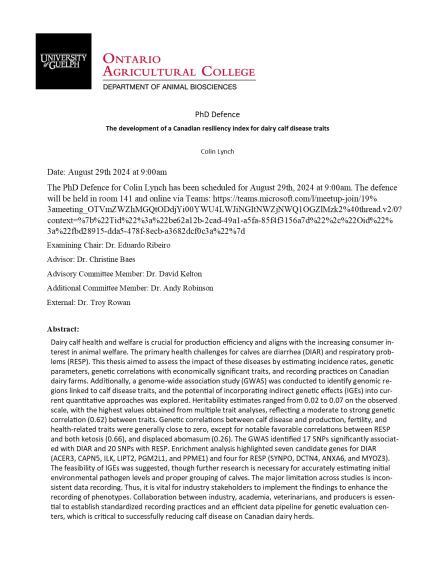Colin Lynch's PhD Defence
Date and Time
Location
Room 141 and Teams: https://teams.microsoft.com/l/meetup-join/19%3ameeting_OTVmZWZhMGQtODdjYi00YWU4LWJiNGItNWZjNWQ1OGZlMzk2%40thread.v2/0?context=%7b%22Tid%22%3a%22be62a12b-2cad-49a1-a5fa-85f4f3156a7d%22%2c%22Oid%22%3a%22fbd28915-dda5-478f-8ecb-a3682dcf0c3a%22%7d

Details
The development of a Canadian resiliency index for dairy calf disease traits
Dairy calf health and welfare is crucial for production efficiency and aligns with the increasing consumer in-terest in animal welfare. The primary health challenges for calves are diarrhea (DIAR) and respiratory prob-lems (RESP). This thesis aimed to assess the impact of these diseases by estimating incidence rates, genetic parameters, genetic correlations with economically significant traits, and recording practices on Canadian dairy farms. Additionally, a genome-wide association study (GWAS) was conducted to identify genomic re-gions linked to calf disease traits, and the potential of incorporating indirect genetic effects (IGEs) into cur-rent quantitative approaches was explored. Heritability estimates ranged from 0.02 to 0.07 on the observed scale, with the highest values obtained from multiple trait analyses, reflecting a moderate to strong genetic correlation (0.62) between traits. Genetic correlations between calf disease and production, fertility, and health-related traits were generally close to zero, except for notable favorable correlations between RESP and both ketosis (0.66), and displaced abomasum (0.26). The GWAS identified 17 SNPs significantly associat-ed with DIAR and 20 SNPs with RESP. Enrichment analysis highlighted seven candidate genes for DIAR (ACER3, CAPN5, ILK, LIPT2, PGM2L1, and PPME1) and four for RESP (SYNPO, DCTN4, ANXA6, and MYOZ3). The feasibility of IGEs was suggested, though further research is necessary for accurately estimating initial environmental pathogen levels and proper grouping of calves. The major limitation across studies is incon-sistent data recording. Thus, it is vital for industry stakeholders to implement the findings to enhance the recording of phenotypes. Collaboration between industry, academia, veterinarians, and producers is essen-tial to establish standardized recording practices and an efficient data pipeline for genetic evaluation cen-ters, which is critical to successfully reducing calf disease on Canadian dairy herds.